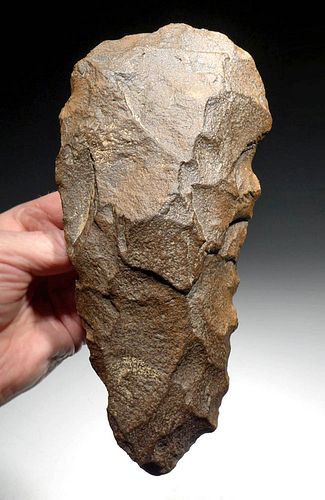Sahara Homo Ergaster Acheulean Stone Lanceolate Axe
Lot 171
About Seller
Artemis Gallery
686 S Taylor Ave, Ste 106
Louisville, CO 80027
United States
Selling antiquities, ancient and ethnographic art online since 1993, Artemis Gallery specializes in Classical Antiquities (Egyptian, Greek, Roman, Near Eastern), Asian, Pre-Columbian, African / Tribal / Oceanographic art. Our extensive inventory includes pottery, stone, metal, wood, glass and textil...Read more
Estimate:
$5,500 - $8,000
Absentee vs Live bid
Two ways to bid:
- Leave a max absentee bid and the platform will bid on your behalf up to your maximum bid during the live auction.
- Bid live during the auction and your bids will be submitted real-time to the auctioneer.
Bid Increments
| Price | Bid Increment |
|---|---|
| $0 | $25 |
| $300 | $50 |
| $1,000 | $100 |
| $2,000 | $250 |
| $5,000 | $500 |
| $10,000 | $1,000 |
| $20,000 | $2,500 |
| $50,000 | $5,000 |
| $100,000 | $10,000 |
| $200,000 | $20,000 |
About Auction
By Artemis Gallery
Oct 7, 2021
Set Reminder
2021-10-07 10:00:00
2021-10-07 10:00:00
America/New_York
Bidsquare
Bidsquare : Exceptional Antiquities Ethnographic Fine Art
https://www.bidsquare.com/auctions/artemis-gallery/exceptional-antiquities-ethnographic-fine-art-7537
Museum-worthy examples of Egyptian, Greek, Roman, Etruscan, Near Eastern, Far East / Asian, Pre-Columbian, African / Tribal, Oceanic, Native American, Spanish Colonial, Fossils, Ancient Jewelry, Fine / Visual Arts, so much more! Artemis Gallery info@artemisgallery.com
Museum-worthy examples of Egyptian, Greek, Roman, Etruscan, Near Eastern, Far East / Asian, Pre-Columbian, African / Tribal, Oceanic, Native American, Spanish Colonial, Fossils, Ancient Jewelry, Fine / Visual Arts, so much more! Artemis Gallery info@artemisgallery.com
- Lot Description
Northwestern Africa, Sahara Desert, Acheulean (Lower Paleolithic), ca. 1.2 million to 500,000 years ago. This stone tool is a lanceolate hand axe with incredible flaking, design, and size! The Acheulean era hand axes were made and used by early humans of the primitive species Homo erectus (ergaster). Light blushes of orange on one side are caused by millennia of this side facing down and absorbing the minerals of the Saharan sands. The other side shows a slightly different contrasting hue - a prized trait only found in specimens from the Northwestern Sahara. The surface areas of the axe display a "desert varnish" - a natural glossy surface from when the tool lay exposed to wind and sand that polished and deposited microscopic layers of silica on the surfaces of the axe for millennia. The chopping tip and edges are intact and well-made with evidence of original prehistoric primary and secondary flaking. These features are a testament to the great age of this Saharan Paleolithic axe! Size: 9.25" L x 4.25" W (23.5 cm x 10.8 cm)
This remarkably aesthetic Acheulean bifacial lanceolate hand axe should not be missed by advanced collectors. The incredible flaking and form demonstrate it was made way beyond what was necessary for a utilitarian purpose. This leads many to theorize that these hand axes were the earliest form of art, flaked by master toolmakers to a degree that conveys prestige, status, and achievement. Seldom will you find examples of this size, condition, and form ever available for sale! The axe was surface-collected from an exposed Lower Paleolithic Acheulian site in the Sahara Desert of Northwest Africa. These Acheulean Lower Paleolithic hand axes from Africa represent the first scientifically documented intelligent tools made by primitive humans. Prior to these Saharan Acheulean hand axes, only crude pebble and flake tools existed in the human fossil record. During this time in prehistory when this Lower Paleolithic tool was made, the Sahara Desert (where this stone tool was found) was a savanna rich in wildlife. Prior to the prehistoric global warming that turned the vast region to desert, early humans lived alongside prehistoric giraffes, bison, and elephants which were vital to their survival. Hunting and butchering these animals would have required specialized tools such as this example.
This piece has been searched against the Art Loss Register database and has been cleared. The Art Loss Register maintains the world's largest database of stolen art, collectibles, and antiques.
Provenance: ex-private Dutch collection, formed in the early 1980s
All items legal to buy/sell under U.S. Statute covering cultural patrimony Code 2600, CHAPTER 14, and are guaranteed to be as described or your money back.
A Certificate of Authenticity will accompany all winning bids.
PLEASE NOTE: Due to recent increases of shipments being seized by Australian & German customs (even for items with pre-UNESCO provenance), we will no longer ship most antiquities and ancient Chinese art to Australia & Germany. For categories of items that are acceptable to ship to Australia or Germany, please contact us directly or work with your local customs brokerage firm.
Display stands not described as included/custom in the item description are for photography purposes only and will not be included with the item upon shipping.
#167894Complete with no repair or restoration. Mineral deposits are intact.Condition
- Shipping Info
-
All shipping is handled in-house for your convenience. Your invoice from Artemis Gallery will include shipping calculation instructions. If in doubt, please inquire BEFORE bidding for estimated shipping costs for individual items.
-
- Buyer's Premium



 EUR
EUR CAD
CAD AUD
AUD GBP
GBP MXN
MXN HKD
HKD CNY
CNY MYR
MYR SEK
SEK SGD
SGD CHF
CHF THB
THB

















